Everest Base Camp Day 3-4: Namche and Thame
Everest Base Camp The Lazy Way
Day 3-4 – Namche to Thame
We have, both of us, familiarised ourselves with the symptoms of altitude sickness, both the mild type and the two serious types that are responsible for the not infrequent buzz of rescue helicopters above us.
In fact, even if we hadn’t been to a talk on altitude sickness in Kathmandu, it would be pretty damn hard to go ignorant, as every checkpoint in Sagamartha National park has enormous signs with lists of symptoms.
So when Zac complains that his lungs hurt, it’s not a particularly big deal for either of us. He’s not breathless and there’s no fluid on his lungs, so he’s not on his way to H.A.P.E. (high altitude pulmonary edema) and support stockings for edema are definitely not required.
I’ve got a slight pain in my chest as well, which I figure is the cold air hitting the base of my bronchial tubes. (My cold has settled into the usual “I-just-gave-up-smoking-hear-me-choke” hawkfest, and we’re neither of us any snottier than anyone else in town.)
For, although it’s bright and warm on the skin up here — a long-sleeved cotton top and jeans is plenty once the sun is up – the air is savagely cold and very dry, and, even at this low elevation, our bedroom is so cold at night that our breath makes clouds in the air.
Nir is definite that the problem is the cold air hitting the bronchial tubes and that Zac should wear his snood pulled up to cover his mouth. As if by magic, the symptoms improve, so much so that Zac decidea to skip visiting one of the clinics in town, and I decide to buy a decent hat and snood for myself.
All the same, I figure that, rather than head to a higher elevation the next day, we should do a second day in Namche acclimatising. Which is to say, we should do the acclimatisation hike we wussed out of today.

Yeah, I know. Lazy, huh?
But, here’s the thing, trekking is supposed to be fun. And, if you’re going to do Everest Base Camp with kids (by way of the Cho-La Pass to boot), you need to take your time over acclimatisation.
We’ve got a 90-day visa, our only immediate commitment is to be in Beijing by New Year, and if there’s one thing I’ve taken from this excellent account of doing Everest Base Camp at speed in February it is “really, really do not rush it”.
And Namche, actually, is rather fun.
The chap at the money exchange will do cash on a Mastercard (and most other plastic for that matter) for a reasonable-in-the-circumstances 8%.
So, with that weight off my mind, we’re good to explore.
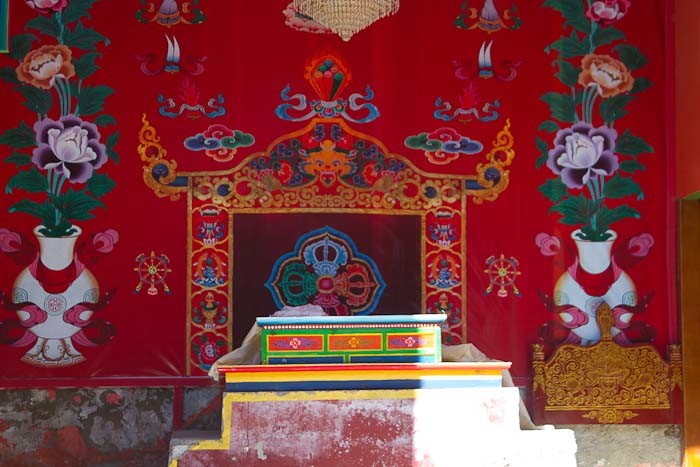
We wander up to the monastery, which has displays on Tibetan Buddhism, and the National Park museum, with its lovely displays on wildlife and birds and traditional life.
We amble around town, paying double the lowland rate for some shit we should have bought in Kathmandu except I wasn’t sure it was necessary, and buy half a yak-load of Snickers at a very reasonable price, plus nak cheese and oranges.
And then we pop round to the Sagamartha Pollution Control Committee. These are the guys who look after getting garbage off Everest, and elsewhere in the national park, managing tonnes upon tonnes of waste each year.
Every single climbing group that comes through town has to register here, after leaving a deposit of hundreds or thousands of dollars (depending on the peak) in Kathmandu. They must fill in a form counting absolutely every piece of potential litter, from oxygen cylinders and kerosene canisters down to every single can of tuna and tinned fruit.
It’s early to say, of course, but it feels like they’re doing a great job. We have seen hardly any litter on the trail which, given everything non-burnable and non-biodegradable has to be carried out, is a credit to the Sherpa people.
Most of what we have seen is loo paper. Which takes, in this environment, over seven years to biodegrade. And mineral water bottles. A major, and disgusting, discredit to lazy Western tourists.
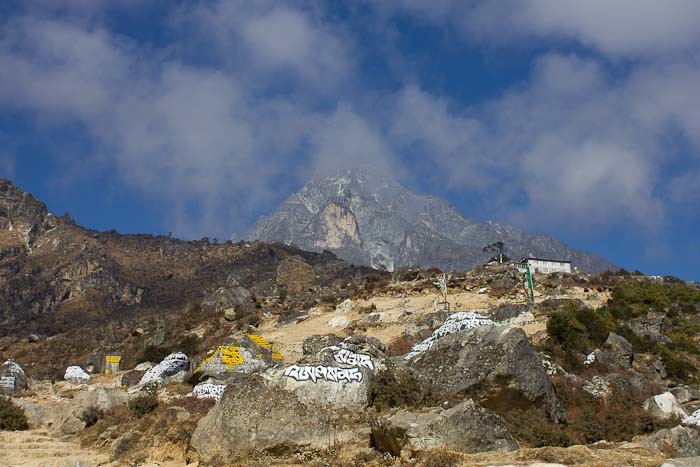
We are fully repaired when we set out west to Thame, up a valley that leads to the Renjo Pass. My bag feels lighter, our hearts are beating at a normal pace, and our breathing’s the same pace as normal, only a little deeper, even when going uphill.
In fact – and I know you’re not supposed to do Himalayan trekking to get fit – we are, we decide smugly, feeling quite fit.
We head up past Namche monastery and its splendid mani stones, and down into a brand new valley, framed by the frozen cataracts and snow cornices of my current second favourite mountain, Kong De, along a dusty, rocky track that winds leisurely up and down through alpine forest of pines and juniper.
It is, in fact, remarkably easy and pleasant walking: a broad, dust and rock track, with plenty of space for the odd chong-ri (yakalo) train to pass.
We meet monks, porters, housewives headed to the shopping paradise of Namche, and pleasingly few trekkers.
We namaste. Folk namaste back.
We stop to fuss over babies. Women fuss over my “baby”, who takes their attentions with good grace.
Rural life unfolds: a man painting a sculpture for the monastery in Thamo, an elderly lady patting yak dung into flat cakes to sun-dry as fuel.
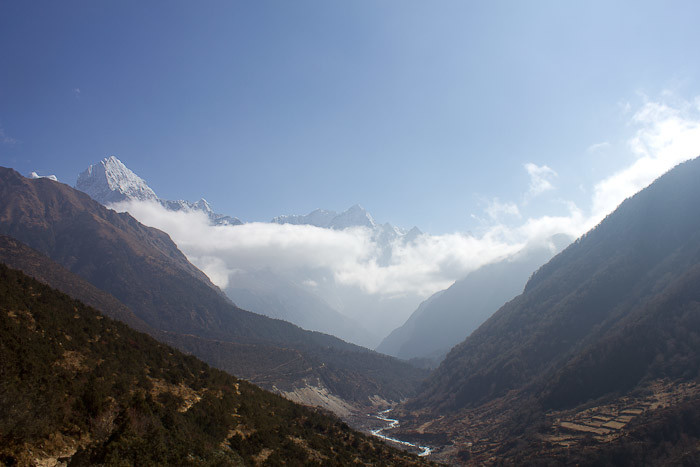
Four pheasants emerge from the woods, in absolute, iridescent splendour, and one, implausibly, takes flight to the top of a tree, and, even more implausibly, almost vanishes.
Who would have thought something so bright could be so well camouflaged?
Zac pulls out his camera and makes a video. And then another video. And then another.
We amble on.
Nir points. A wild goat! A mountain goat! Completely, and wonderfully, unafraid, decked in a fountain of a glamrock mane, he leaps at ludicrous speed down a sheer ravine.
Nepal is a poor country, one of the poorest in the world. But the Sherpa people care enough about conservation – which aligns well with traditional Tibetan Buddhist beliefs and traditional land management – and probably the tourist dollar too that these goats can wander, unafraid.
As compared to places like Bokor National Park, where we were treated to a meal of illegal game, and the systematic illegal and unethical logging we’ve seen across Asia, in national parks and elsewhere, Sagamartha National Park is a credit to Nepal.
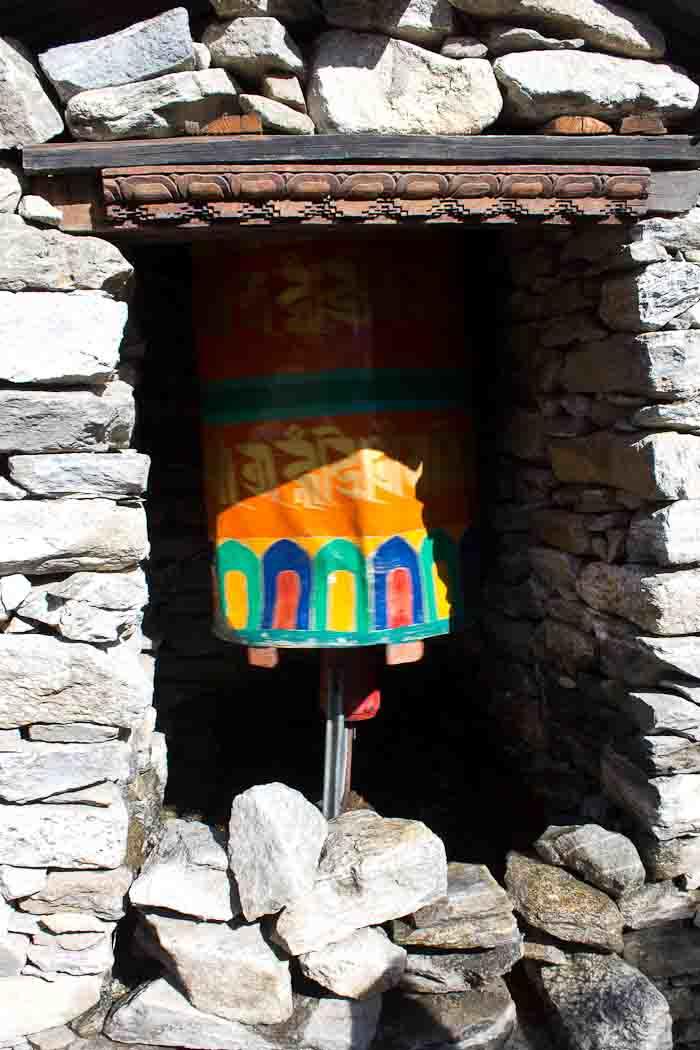
The 8000 or so Sherpas who live in the region, plus the myriad tourist businesses, run on hydro and solar power only. So it seems very, well, Nepali that the village of Thamo boasts not only a hydro-power sub-station but water-driven prayer wheels, sending their prayers to heaven with the pace of the mountain stream that powers the wheel (judging by its dents, I’m guessing the water flows faster than planned during the monsoon).
I’d sniggered, slightly, at the notion of Hindus performing prayer and puja using smartphone apps. But a water-driven prayer wheel is, pretty much, an earlier version of the same thing.
(Nepali religion, by the way, confuses the hell out of me. It seems rather pleasantly merged. Nir, who is firmly Hindu, spins the prayer wheels like any good Buddhist – although, so too does my atheist child. I guess it’s just that Tibetan Buddhism is an easy religion to get along with.)
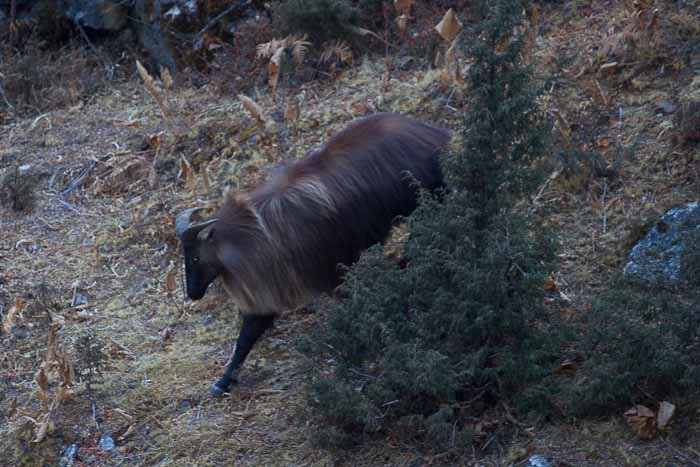
We amble through, on and up the valley, and the path climbs over an exposed corner that feels, with the wind blasting across it, rather sheer and, compared to the substantial width of the path at lower elevations, a little narrow.
Across the valley and below us, a cataract roars, white and savage, down the mountains, and the blue Dudh Koshi hisses loudly hundreds of metres below us.
Queasiness hits, my first hint of vertigo on the trail outside of suspension bridges, and I cross the corner fast, with one hand on the wall and repeated injunctions to Zac to stay to the wall side.
I’m trying not to inflict my vertigo on him. I remember my father doing the same with me – inching along cliff paths to show me it was OK. It worked, at least until I was an adult, and my own fears kicked in.
It is, I think, the roar of the river below that does it. The roar that pulls you down…
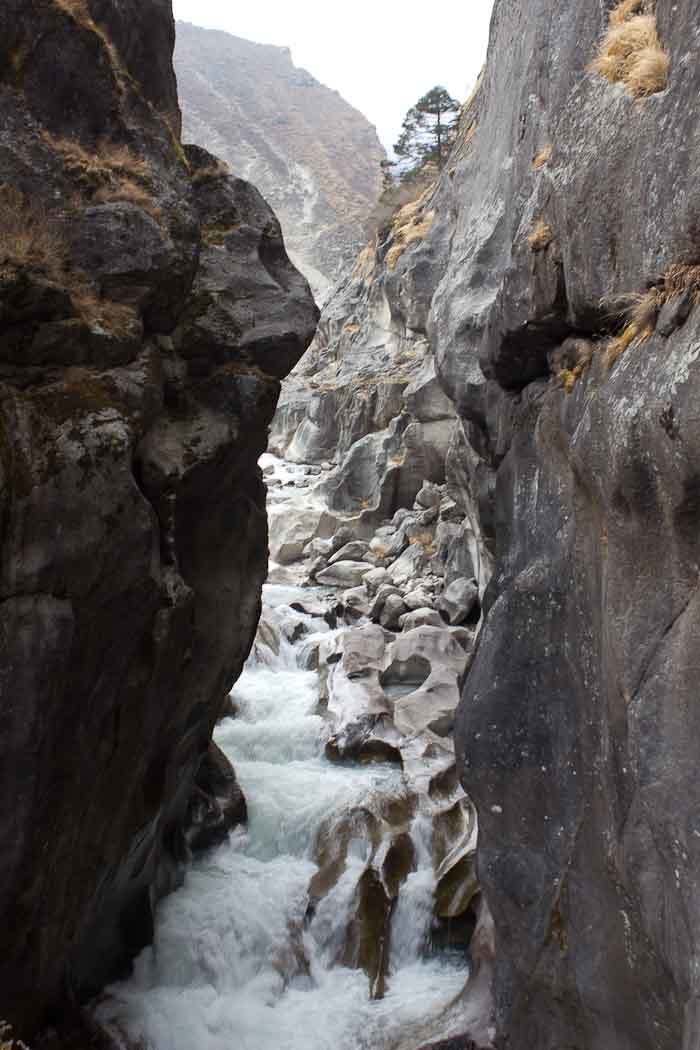
Down what feels like a precipice, over a solid bridge that spans a series of waterfalls which have smoothed the rock to the sinuous curves of a Middle Eastern wadi, up another precipice on the valley side and over and we’re in, bizarrely, what feels like a different landscape, dominated less by Kong De than by Kham Serko.
There is ice, here, not just clinging to the high sides of the valley but frozen in elaborate configurations on the rocks that the river tumbles past, great clusters of rime, like rocky chandeliers.
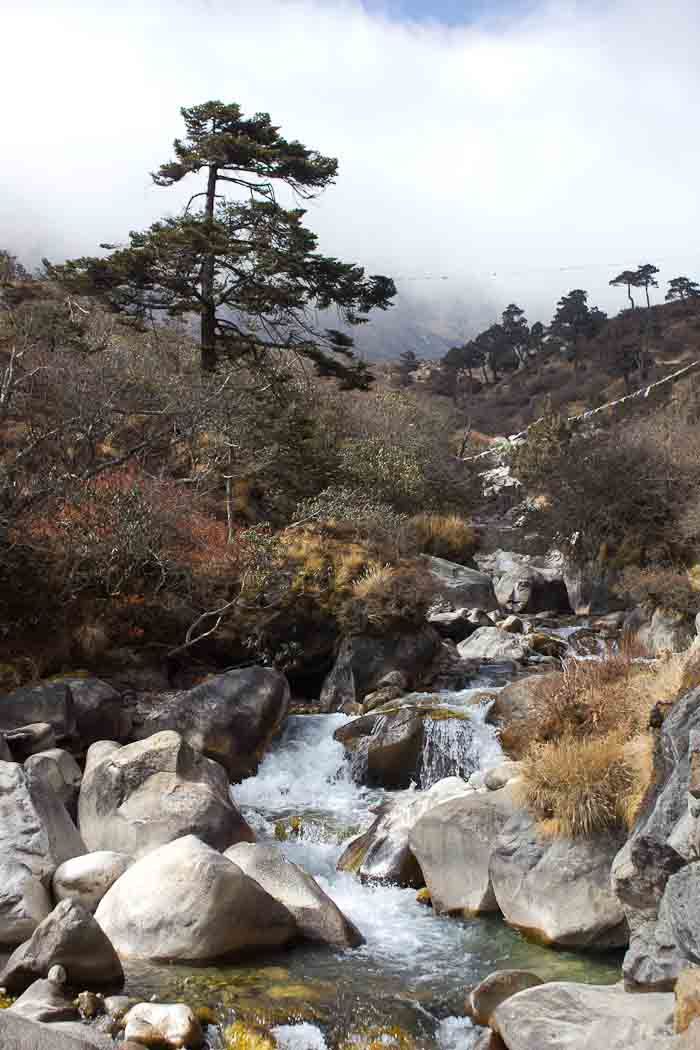
The landsape is still that of autumn, sere and dry, but an autumn that’s fading rapidly to winter.
Stunted and gnarled junipers cling to the browning land, and shrubs sprout leaves that are red with autumn amid the bright white rime.
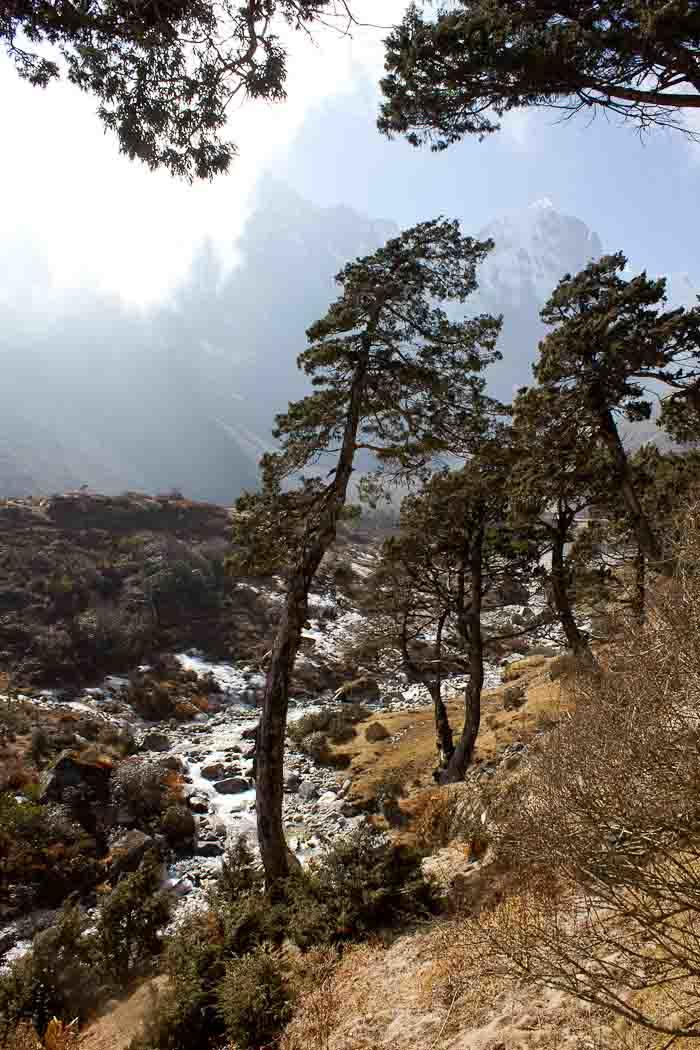
Grasses are dying, although amid the drystone terraced fields, their earth dry and dusty, young calves still scratch for forage.
We’re here! In Thame! 3800 metres, or 12,500 feet, and still a bagatelle compared to where we’re headed to.
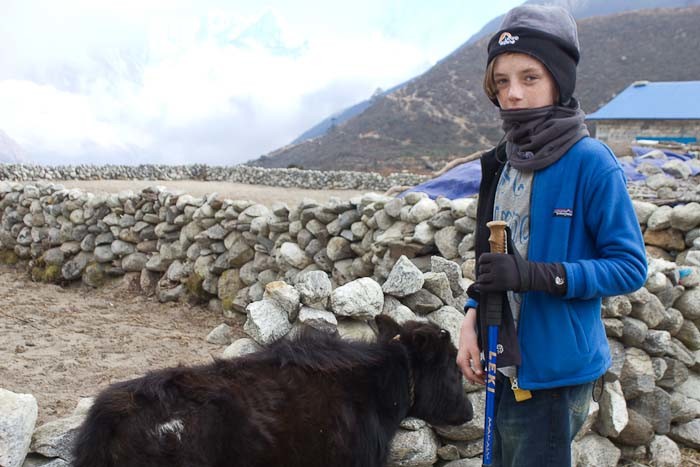
We break for lunch in the sun room of a lodge whose proprietor is a “decorated climber”, and watch clouds racing up and down the valley.
“Chisu,” says Nir, who’s teaching the pair of us Nepali. (Zac is of the view that once you have the phrases “Namaste” (hello) and “Chisu tsar” (very cold), you have all you need to get by socially in the Himalayas.)
Yep, I think, it’s going to be cold. We’re also running late.
Whatevs, I think. I’ve got down jackets, over-gloves, headtorches and a balaclava in my daypack. It’s going to be absolutely fine.
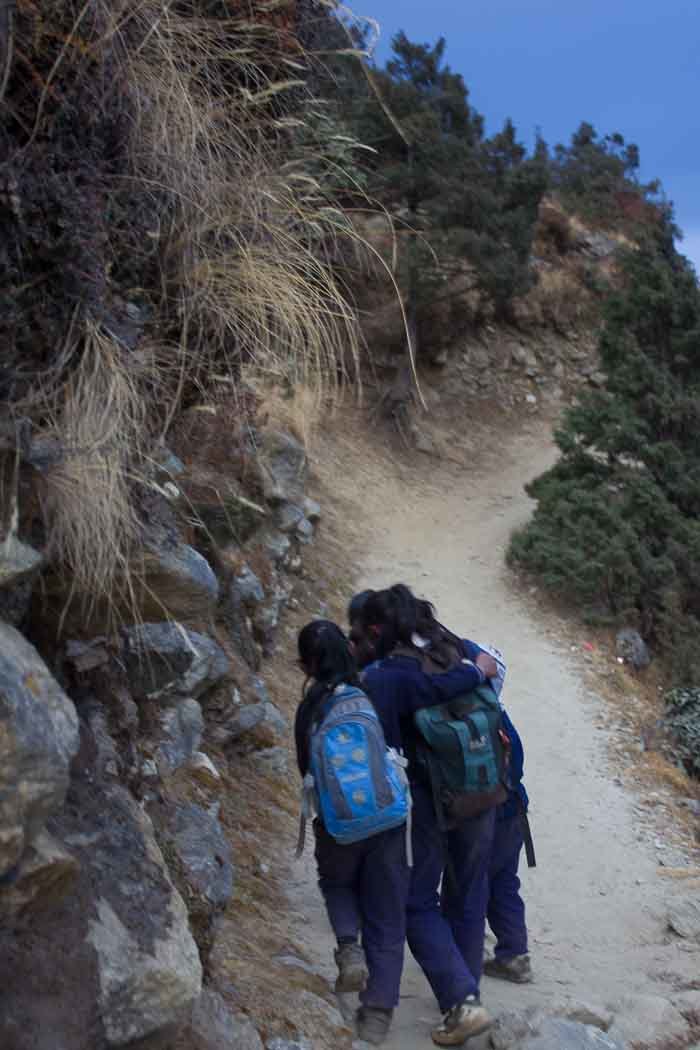
We are just passing the brightly coloured Buddha and Rinpoche duo that adorn the base of our second “precipice”, and I am gearing to ascend the fearsome slope ahead of me, when it becomes apparent that school is out.
A gaggle of Sherpa boys in dusty school uniforms race down the cliff and up the other side, running with all the vigour and roughly the pace that a bunch of London school kids would run on the flat.
I laugh, with a note of mild despair. Nir laughs too.
Behind them, a gaggle of girls descend in a rather more ladylike fashion, although they too are wearing trousers.
“Do you reckon they just don’t want to hang out with the boys?” I ask.
“Looks that way,” says Zac.
They catch up with us, and practice their English.
How old is my daughter? Oh! He’s a boy! Only twelve! He’s so TALL!
Which, by Sherpa standards, Zac is. Our interlocutors are fourteen and fifteen, and the taller of the pair MIGHT reach to his chin.
We amble up hill, chatting, and catch one of the bigger boys, towing his little brother home by one hand.
They’re walking to Thamo. They walk this way, an hour in, an hour out, five days a week, to go to school.
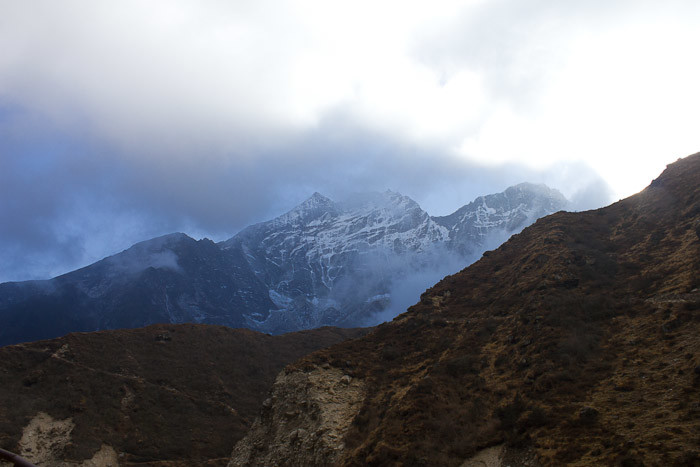
Somehow, between stops for Snickers, nak cheese, oranges and water, stops for photography, stops to do up shoelaces, stops to add or remove layers, stops to adjust hiking poles, stops to spin prayer wheels, stops to poke at ice, and stops to catch one’s breath we are rapidly running remarkably late.
Not that it matters particularly at this elevation. We seem to take 75% more time than the Nepali cartographers behind my map anticipate each hike should last, and 25% more time than Lonely Planet thinks we should take.
But, hell, this isn’t a race. It’s supposed to be fun. And for us, fun means slow.
The cloud continues to roll in. And then it opens, high in the sky, and a bright shaft of light illuminates the very top of Kong De, its tall and sculpted cornices, its many jagged cliffs, clouds surrounding it on every side.
“Look!” says Zac. “It’s like a gateway into another universe in the sky.”
And so it is. It’s like the other universes in Philip Pullman’s Lyra series, just hovering there, a window, as if it’s floating, gently illuminated by the alpenglow.
It’s wonderful. Truly, truly wonderful.
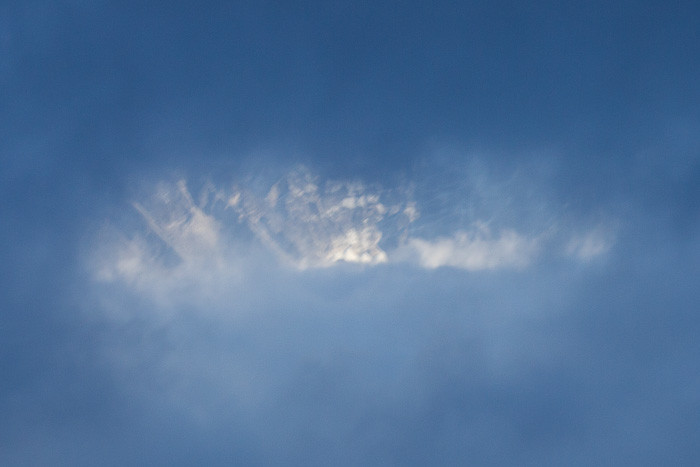
“We get back to Namche at 7, if we keep walking like this,” says Nir, with a note of mild reproach.
This is a bit of a disaster, potentially, since sunset hits around 6, but will come earlier now the valley’s almost obscured with cloud, and I’ve only brought one headtorch, though there’s a light on my mobile phone.
Still, as places to practice walking in the dark goes, this is relatively safe.
And, for the first time that I’ve seen, in fact, Zac gets into the zone. He’s just walking. Not stopping, not delaying, just in a steady rhythm of step-step-stick, rising inexorably and silently through pine forest.
It is dark when the mani stones of the monastery loom out of the darkness, and the dim lights of Namche Bazar appear in the distance.
“Tired?” I ask Zac.
“Not particularly,” he says.
The “strenuous seven-hour day hike” has taken us nine hours. But we’re feeling neither the strain nor the altitude and, so far, I feel, all is good.
We’re not in a group, and we’re not on a schedule, so we can set our own pace.
Tomorrow we head to Khumjung, where, Nepali maps are at pains to point out, there is a monastery with a yeti skull! Woot!
You can start from Day 1 of our Everest Base Camp trek here, read the previous post in my Everest Base Camp trek series here or the next post here.
If you’re thinking of doing the Everest Base Camp trek, I recommend my Everest Base Camp FAQs.

This is incredible! I have always hesitated doing this hike due to fitness and altitude concerns – and you are doing it with your child! Its an incredible hike and experience – enjoy!
Well, I had a decent idea he was alright at altitude — he’s been above 4000m without problems before. But, to be honest, provided you take it slowly, you don’t need to be superfit at all. We’ve met people over 70 on the trail, although my son’s so far the youngest we’ve come across…
I am so enjoying reading this. It would be a dream come true to make it to Everest Base Camp with my boys. Loving it, looking forward to the next installment.
And coming up, I hope! Internet here is not exactly world-beating, though it does exist…
What a fantastic experience! So glad you could obtain money, especially at such a good price – the Nepalis really do sound a good and honest people. Could you ask Nir if he has ever led such a laid back pair as you?
I could try! Zac’s certainly the youngest person he’s guided…
I’m trying to remember right now if I ever told you the story of how my brother got hit with altitude sickness on the Tibetan side (bad enough to need extra oxygen, not as serious as on the Nepali side because there’s a road down but definitely worrisome), but think I have so I’ll spare you the story.
Instead my anecdote of the day is how much I loved hearing from our Sherpa guide in Tibet (he grew up in the park on that side of Everest) that if Sherpa descend too quickly they ALSO get altitude sickness if they descend too quickly- won’t kill you but Sherpas can get very dizzy and such. I was amused. 🙂
I think the reason so many people get it on the Tibetan side is precisely because there is a road in. So you can just drive up rather than walking up. Although, as you say, you can get down in a car rather than by yak, mule or chopper…
Wow.. I just finished catching up on your blog after finding your website oh say about 3 months ago. Your website has been my bedtime reading pretty much every night since then. Yours and zac’s adventures have been amazing!
Your style of writing is something I can relate to. I feel like I’m there with you when you tell your stories. I’ve laughed out loud many times and enjoy your very hilarious use of expletives.
I plan to take my family on an extended trip around the world someday and your blog has inspired me in many different ways. Before we do go in a few years ( my kids are 7, 5, 2), I’ll be sure to read your stories and tips again.
One question for you, when would you suggest me taking my family on a trip? I don’t want to do it too late when my eldest is in her “I wouldn’t be caught dead with you in the same room” phase or too early when my youngest is still in her “whatever you do this year, I’m only going to remember one hundredth of what we do, just an FYI” phase. 🙂
Enjoy the rest of your Everest trek! I did the Annapurna trek Before Kids and definitely want to do the Everest trek as well.
I’d really recommend the Everest trek BUT a variation on it, like the Gokyo Cho-La route, or an easier hike up to Chhukung and back down. The main route can get really, really busy.
As regards ages, I’d say get out before the oldest is in her teens, but after the youngest is past the wiping stage, and you’ll be good. But the key thing is to do it at some point. Some people get so hung up on planning they never, ever do it…